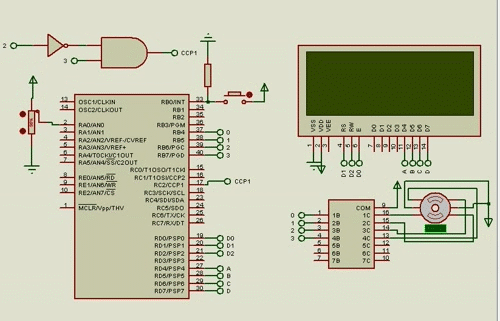#include <16F877A.h>
#device adc = 8
#use delay(clock = 20MHz)
#FUSES NOWDT, HS, NOPUT, NOPROTECT, NODEBUG, BROWNOUT, NOLVP, NOCPD, NOWRT, NOWRT
#include <lcd.c>
#define size 8
#define PIN_1 PIN_C4
#define PIN_2 PIN_C5
#define PIN_3 PIN_C6
#define PIN_4 PIN_C7
unsigned int A, B, i = 0, POSITION;
unsigned int16 VALUE;
unsigned int8 MOTOR[size] = {64, 96, 32, 48, 16, -112, -128, -64};
unsigned int16 posicao1[size] = {45, 90, 135, 180, 225, 270, 315, 360};
unsigned int16 posicao2[size] = {360, 315, 270, 225, 180, 135, 90, 45};
unsigned int DIAS, HORAS, MINUTOS, SEGUNDOS = 0;
char setaH[size] = {
0b00000,
0b00100,
0b00110,
0b11111,
0b00110,
0b00100,
0b00000,
0b00000
};
char setaA[size] = {
0b00000,
0b00100,
0b01100,
0b11111,
0b01100,
0b00100,
0b00000,
0b00000
};
char graus[size] = {
0b00110,
0b01001,
0b00110,
0b00000,
0b00000,
0b00000,
0b00000,
0b00000
};
int1 nuevopulso = 0, cambio = 0;
int16 TFB = 0, TFS = 0, TF = 0;
float TEMPO = 0.0, frequencia;
#int_ccp1
void ccp1_int(){
if(cambio == 0){
TFS = CCP_1;
setup_ccp1(CCP_CAPTURE_RE);
cambio = 1;
}else{
TFB = CCP_1;
setup_ccp1(CCP_CAPTURE_RE);
cambio = 0;
if(nuevopulso == 0){
nuevopulso = 1;
}
}
}
#INT_TIMER0
void TIMER0_isr(void) {
if (nuevopulso >= 1){
TF = (TFB - TFS);
TEMPO = TF * 1.0 / 1000.0;
frequencia = 1.0 / (TEMPO / 1000.0);
nuevopulso = 0;
}
}
#INT_TIMER1
void TIMER1_isr(void) {
A = input(PIN_B0);
B = input(PIN_B1);
}
void main(){
setup_adc_ports(AN0);
setup_adc(ADC_CLOCK_DIV_2);
setup_timer_0(T1_DIV_BY_1);
setup_timer_1(T1_INTERNAL|T1_DIV_BY_1); //13,1 ms overflow
setup_ccp1(CCP_CAPTURE_RE);
enable_interrupts(int_ccp1);
enable_interrupts(INT_TIMER1);
enable_interrupts(INT_TIMER0);
enable_interrupts(GLOBAL);
lcd_init();
lcd_set_cgram_char(4, graus);
while(TRUE) {
output_high(PIN_B5);
output_low(PIN_B6);
output_low(PIN_B7);
SEGUNDOS++;
if ( SEGUNDOS > 59 ){SEGUNDOS = 0 ; MINUTOS++ ;}
if ( MINUTOS > 59 ){MINUTOS = 0 ; HORAS++ ; }
if ( HORAS > 23 ) {HORAS = 0 ; DIAS++ ; }
lcd_gotoxy(1, 1);
printf(lcd_putc,"\f\t\t\tMOTOR OFF !");
lcd_gotoxy(1, 2);
printf(lcd_putc, "%02u:%02u:%02u",HORAS, MINUTOS, SEGUNDOS);
lcd_gotoxy(21, 1);
printf(lcd_putc, "DIAS PARADO: %u",DIAS);
delay_ms(1000);
while(A == 1 && B == 0){
output_high(PIN_B6);
output_low(PIN_B7);
output_low(PIN_B5);
VALUE = read_adc();
lcd_set_cgram_char(2, setaH);
lcd_gotoxy(1, 1);
printf(lcd_putc, "\f\t\tMOTOR ON ! \t%c", 2);
lcd_gotoxy(1, 2);
printf(lcd_putc,"ANGULO = [%lu%c]" posicao1[i], 4);
lcd_gotoxy(21, 1);
printf(lcd_putc,"W = %.2f rad/s", frequencia * 2 * 3.1415);
lcd_gotoxy(21, 2);
printf(lcd_putc, "F = %.2f Hz", frequencia);
POSITION = MOTOR[i];
output_bit(PIN_1, POSITION & 16);
output_bit(PIN_2, POSITION & 32);
output_bit(PIN_3, POSITION & 64);
output_bit(PIN_4, POSITION & 128);
i = (i + 1) % (sizeof(MOTOR) / sizeof(int));
delay_ms(VALUE);
}
while(A == 0 && B == 1){
output_high(PIN_B7);
output_low(PIN_B6);
output_low(PIN_B5);
VALUE = read_adc();
lcd_set_cgram_char(3, setaA);
lcd_gotoxy(1, 1);
printf(lcd_putc, "\f%c\tMOTOR ON !", 3);
lcd_gotoxy(1, 2);
printf(lcd_putc,"ANGULO = [-%lu%c]" posicao2[i], 4);
lcd_gotoxy(21, 1);
printf(lcd_putc,"W = %.2f rad/s", frequencia * 2 * 3.1415);
lcd_gotoxy(21, 2);
printf(lcd_putc, "F = %.2f Hz", frequencia);
POSITION = MOTOR[i];
output_bit(PIN_4, POSITION & 128);
output_bit(PIN_3, POSITION & 64);
output_bit(PIN_2, POSITION & 32);
output_bit(PIN_1, POSITION & 16);
i = (i - 1) % (sizeof(MOTOR) / sizeof(int));
delay_ms(VALUE);
}
}
}






















